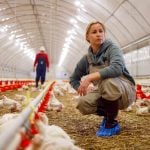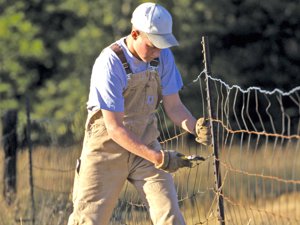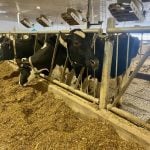Getting professional about HR is a strategy that pays whether the farm is big or small, and whether workers are family or hired

The labour gap in Canadian agriculture continues to widen and is expected to double by 2025. That’s prompting more farm businesses to focus on recruiting and retaining employees.
At the same time, with employment standards constantly changing, and with considerations such as health and safety and workers compensation to think about, some farms are beginning to develop a human resource (HR) strategy to help them find the right people and then to keep them.
Farm businesses lag behind other industries when it comes to looking at HR strategies, policies and practices. That’s partly because many are still family operations, while others are just reaching the point where they need to hire outside employees.
It turns out that all farms, regardless of size or structure, and whether they are family-run corporations, partnerships or sole proprietorships can benefit from some HR planning.
“Human resource planning should be part of overall farm business management just like planning for production and marketing,” says Khosi Mashinini, a farm business management specialist with Manitoba Agriculture. “A strong and effective HR plan will strengthen the people side of the business, which includes hiring and retaining high-performing employees.”
Mashinini speaks often on HR, and presents tips for developing a HR strategy based on Manitoba Agriculture’s workbook, Human Resource Management for Farm Business. The workbook is available free online (see list of resources below), and outlines a step-by-step process for developing a HR management strategy for any farm size or type.
1. Self-evaluation

The recruitment process can’t begin until the business knows what it’s looking for. Mashinini recommends completing a self-evaluation to help the business identify what it is currently doing in terms of HR and what it needs to start doing. The self-evaluation helps the farm to identify its HR priorities and to develop objectives with timelines. “The goal is to recruit and retain good employees for the business,” Mashinini says. “You want to hire people who fit into your business culture and ensure everyone understands the role of the new person coming in. You also have to consider the benefits you as an employer will offer.”
2. Creating an identity

Developing an identity for the farm business before beginning the recruitment process helps to set it apart as an employer of choice and attract people to want to work for it. “What is your farm all about and what are your beliefs and values?” asks Mashinini. “How are you different from the farm two miles down the road? Creating a marketable identity and reputation helps you differentiate your business when you are recruiting new employees and lets them know why you are unique and the benefits they will get from being your employee.”
3. Recruiting

The next must-have is a job description that clearly identifies the job’s duties and responsibilities. It should also outline the skills and experience needed to do the job, including any educational or licensing requirements. The job description should include what conditions the employee can expect to be working under. Not only does a job description give candidates a clear idea of what the position is, it also helps keep the employer focused during the interview process to make sure their questions are relevant to the position and the skills they are seeking.
There are many ways to get the word out about the vacancy, including local and industry media, social media, posters in local businesses and government job sites.
But don’t underestimate the value of networking, talking with current employees, neighbours and others in the industry to help find the right candidate. Mashinini advises “antenna recruiting” — always observing the people around you and looking for people who could make good employees now or in the future.
4. Hiring

The hiring process is important because an employee should add value to the farm business, so hiring the right person is critical. “A bad hire can affect your business’s bottom line, staff morale, equipment and assets,” says Mashinini.
A standard hiring process can save time and help ensure employers choose the right person for their business. That process should include everyone on the farm who will be involved in interviewing candidates and/or responsible for supervision.
Review applications all at the same time to compare them. If there are a lot of qualified candidates, consider drawing up a shortlist and conducting a brief, pre-screening interview by phone with them. “A brief 10-minute conversation to ask them why they are interested in the job and what they know about the farm will help you learn more about them so you can weed out any candidates that may not fit,” says Mashinini.
Once the final interviewees are decided, the interview process should not exceed an hour and the candidate should be doing most of the talking. It’s important to ask all candidates the same questions to make it possible to compare them fairly. Also make sure you have the job description and the interview questions printed out ahead of time. Behavioural questions, such as those that ask candidates to give examples of their prior experience in specific situations, give a better understanding of the candidate’s capabilities and the way they are likely to handle or react to different scenarios.
Always make the employment offer to the chosen candidate in writing and ensure both the employer and employee sign it when the candidate accepts the offer.
5. Orientation and training

The first day on a new job can be daunting, which is why an orientation process that makes the new employee feel welcome can be an important first step in developing an employee who will be happy and productive.
Besides introducing them to the crew, the orientation should ensure the person knows what their job is and understands the processes involved and the employer’s expectations of them. They need to know who to ask for help and understand how to do the job safely. An employer should answer any questions that the employee has, which may not all be directly related to the actual tasks they will perform. A new employee may want to get a feel for how they will fit into the farm, what it will be like to work there and who they take orders from.
Most new employees will need training, so a step-by-step plan that is well thought out ahead of time will save a lot of time and confusion. It’s important to cover everything they will need to know to do the job and make sure they understand it fully. Don’t fall into the trap of thinking that if you are only hiring family members they don’t need training. They may have grown up on the farm, but don’t necessarily know how to do some tasks. As well, if there are other non-family employees, it’s important to make sure they are all treated the same way and don’t perceive that the relative is getting special treatment.
6. Motivating employees

Regular staff meetings and a commitment to ongoing communication are key to retaining employees, as is a plan for ongoing training and professional development that can help keep them motivated and offer opportunities for promotion if that’s what they are seeking.
In fact, motivating employees and monitoring their performance is another key aspect of any HR strategy. “Motivated staff create a positive, productive working environment and are much more likely to remain with the business,” says Mashinini.
Motivation always begins with a competitive salary but “fair” salaries might also include paid sick and vacation time that is above and beyond the minimum standards, or flexible working hours. Motivators can be things like salary and health benefits, or can be more intrinsic such as good communications and showing respect and appreciation for what employees do. What motivates one employee may not motivate another, so it’s important to put yourself in their shoes, says Mashinini. “Think of what you would like and how you would want to be treated,” she says.
Employers should do a performance review at least once a year because employees don’t perform to the best of their capabilities if they don’t know what the employer expects from them. “Many times employees ask two common questions: what is my job, and how am I doing? Providing feedback that shows you appreciate and value what they do is a primary and ongoing responsibility for supervisors and farm owners,” says Mashinini. She suggests employers immediately recognize the efforts of employees, especially when they are going beyond what is expected.
“Whenever you are giving recognition, don’t just recognize the high-performing employees,” Mashinini says. “Look for opportunities to encourage everybody, because when employees feel encouraged they are happier, more productive and will stay longer with you.”
7. Resolve conflicts

Conflicts may arise between employees, or between employees and managers or supervisors, or among family members involved in the farm operations. Employers need to deal with such conflicts swiftly.
“If conflict is not addressed it can lead to low morale, decreased production and damage to the reputation of your farm business, and may lead to constant turnover of employees,” says Mashinini.
In some cases it may be necessary to impose some kind of disciplinary action, but first it’s vital to understand the situation. Speak to each person involved in the conflict separately and listen objectively to their perspective, without taking sides. Then bring them together to discuss the matter. “Show them how their behaviour is affecting the business operation and put the emphasis on the employees or whoever is involved to create a conflict solution,” says Mashinini.
“Write it down and get them and the employer to sign the document so there is a record in case anything happens in the future. Sometimes the conflict is a simple misunderstanding, which is why it’s important to have good communications and a conflict resolution strategy to fall back on.”
8. Create manuals

Developing an employee and standard operating procedures manuals provides clear, “how-to” instructions about how the farm business is to run and provides guidance to employees when their supervisor or manager isn’t available to help them.
The employee manual states what the farm business expects from its employees and what they can expect from the business in return. The standard operating procedures set out the steps and tasks to get different jobs done on the farm. All too often this knowledge ends up in someone’s head and not on paper, so it’s vital that this experience and knowledge is written down for employees who aren’t familiar with how things are done on the farm.
“An HR strategy is more than just hiring and retaining people,” Mashinini says. “A strategy should align with the farm’s goals and improve the quality of the people that it hires. A solid and strong HR plan will provide positive results for the farm business.”














